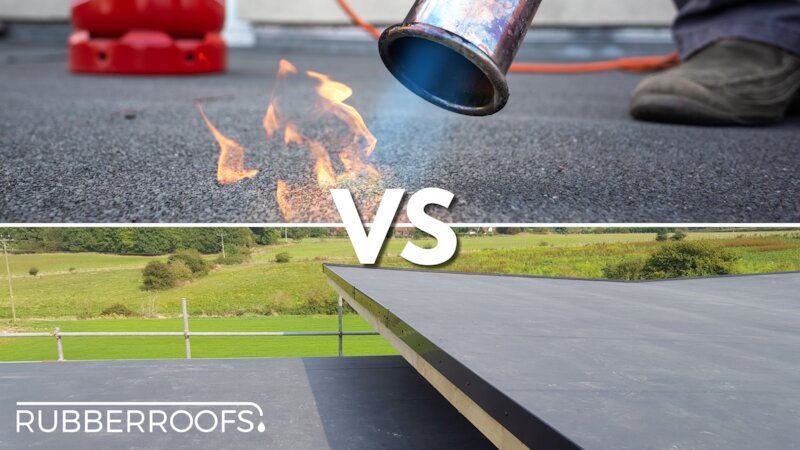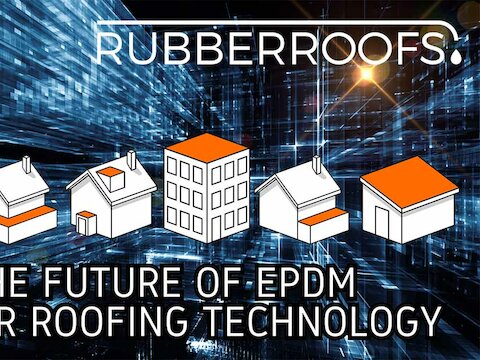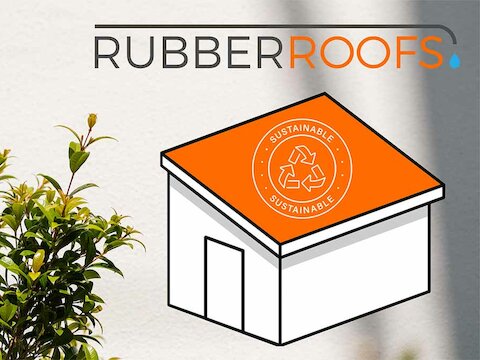EPDM Roofing Vs Bitumen Felt Roofing

Throughout the years, EPDM has proved its worth, standing against the largely popular Bitumen Felt roofing solution; however, in this blog post, we want to shine a light on the comparisons between EPDM roofing and a Bitumen Felt-based roofing system.
What is EPDM?
EPDM, or Ethylene Propylene Diene Monomer is a synthetic rubber roofing membrane that was first used in the 1960’s. With ample durability, impressive fire resistance, ease of installation and sustainability only adding to the benefits of EPDM roofing (see our EPDM Rubber Roofing for Green Building Project blog), it has become synonymous with high-quality and durable roofing in the construction sector.
What is Bitumen Roofing Felt?
Bitumen roofing Felt, also known as built-up roofing (BUR) is a flat roofing material which is a multi-layered system coated in Bitumen. This felt is highly effective at weatherproofing, however, it lacks many of the benefits that EPDM provides, including lifespan, durability, installation ease and cost over time.
Comparing EPDM Roofing against Bitumen Felt Roofing
As stated above, EPDM brings many benefits to the table which Bitumen Felt-based systems lack. Below is a breakdown of each factor we believe is important when comparing roofing solutions.
Fire Rating
Comparing both solutions, there are a number of points to consider:
Fire-Rated EPDM
Techno Rubber EPDM meets the criteria for BROOF T4 certification. This certification guarantees that the fired-rated EPDM system is effective for controlling both the spread and duration in the event that the membrane is exposed to flame to help prevent damage and potential injury.
Felt Roof Fire Rating
Felt roofs are fire resistant, however, modified bitumen has a tendency to lose fire resistance over its lifespan; this is accelerated greatly by roof areas which experience high foot traffic. Re-coating can be done, however, this adds to the overall maintenance cost.
Fire Rating Conclusion
Although both products are fire resistant, EPDM remains much more resistant to fire damage and provides greater safety over a longer duration.
Life Expectancy
Life expectancy and cost of a roofing solution can play a large role in whether or not the material is suitable for a project. Comparing these solutions shows the following:
EPDM Life Expectancy
EPDM has an exceptional life expectancy, with an average span in excess of 50 years. We are confident in the EPDM solutions that we provide a free downloadable 20-year warranty.
Felt Flat Roof Life Expectancy
Bitumen-felt roofs last, on average, a minimum of 10 years, with torch-on roof felting being the most durable and carrying a life expectancy of 15-30 years. However, as stated above, owing to how the felt and granules degrade over time, this roofing solution can become much less effective, leading to heightened costs if replacement or recoating is necessary to preserve its weatherproofing or fire resistance properties.
Life Expectancy Conclusion
Both EPDM Roofing and Bitumen Felt roofing will last over a 10-year period, however, EPDM is much less prone to degradation over time, preserving its safety and fire rating for a much longer period than its Felt-based counterpart.
Installation
Installation is an important factor when considering cost, and with this, we have broken down the ease of installation below:
EPDM Roofing Installation
EPDM can be installed with relative ease and is often complemented by both contractors and DIYers alike. Owing to its cold installation (no flame or heat required), mixed with its use of contact adhesives, it is a much more straightforward installation than Bitumen-Felt systems.
Bitumen Felt Roofing Installation
Bitumen Felt, to increase its longevity, is a hot install; requiring that the felt be torched on which can be a higher safety risk, complicated and time-consuming process. Unlike EPDM, which can be undertaken by DIYers, Felt based systems require a professional installation.
Installation Conclusion
Taking the above into account, we believe that EPDM is much easier and safer to install, requires much less time, and can be handled by both DIYers and contractors. This helps reduce costs further, with EPDM roofing spreading its cost efficiency over time.
Cost Considerations
Bitumen Felt Roofing, in comparison with EPDM, is the cheaper option, however, this does not make it the most cost-effective.
The initial cost of EPDM is higher, but the quality of the product, the safety considerations, ease of installation and overall durability of the system, mixed with a life expectancy of over 50 years (including a 20-year warranty), make the initial higher costs much more beneficial in the long term.
Conclusion
Although felt-based solutions are a good way of keeping initial costs low, we’re confident in saying that EPDM roofing for cost-over-time is much more efficient. Considering the benefits EPDM provides over felt tips the balance and makes us even more confident in our product. We supply high-quality Techno EPDM rubber roofing, containing the benefits and adhering to the weatherproofing and fire-rating factors above.






